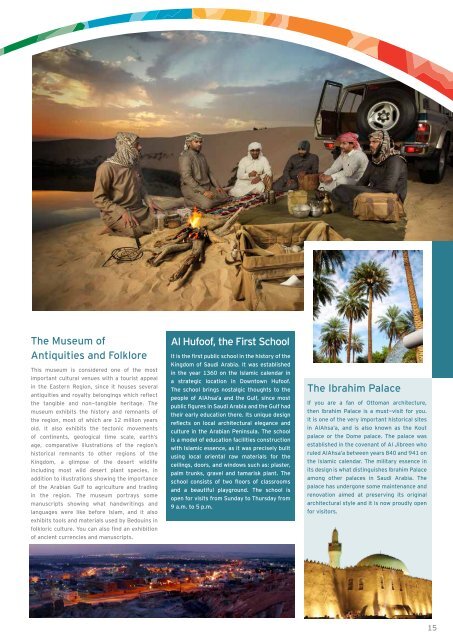Saudi Tourism
Brochyre-Tourisn-English
Brochyre-Tourisn-English
You also want an ePaper? Increase the reach of your titles
YUMPU automatically turns print PDFs into web optimized ePapers that Google loves.
The Museum of<br />
Antiquities and Folklore<br />
This museum is considered one of the most<br />
important cultural venues with a tourist appeal<br />
in the Eastern Region, since it houses several<br />
antiquities and royalty belongings which reflect<br />
the tangible and non-tangible heritage. The<br />
museum exhibits the history and remnants of<br />
the region, most of which are 12 million years<br />
old. It also exhibits the tectonic movements<br />
of continents, geological time scale, earth’s<br />
age, comparative illustrations of the region’s<br />
historical remnants to other regions of the<br />
Kingdom, a glimpse of the desert wildlife<br />
including most wild desert plant species, in<br />
addition to illustrations showing the importance<br />
of the Arabian Gulf to agriculture and trading<br />
in the region. The museum portrays some<br />
manuscripts showing what handwritings and<br />
languages were like before Islam, and it also<br />
exhibits tools and materials used by Bedouins in<br />
folkloric culture. You can also find an exhibition<br />
of ancient currencies and manuscripts.<br />
Al Hufoof, the First School<br />
It is the first public school in the history of the<br />
Kingdom of <strong>Saudi</strong> Arabia. It was established<br />
in the year 1360 on the Islamic calendar in<br />
a strategic location in Downtown Hufoof.<br />
The school brings nostalgic thoughts to the<br />
people of AlAhsa’a and the Gulf, since most<br />
public figures in <strong>Saudi</strong> Arabia and the Gulf had<br />
their early education there. Its unique design<br />
reflects on local architectural elegance and<br />
culture in the Arabian Peninsula. The school<br />
is a model of education facilities construction<br />
with Islamic essence, as it was precisely built<br />
using local oriental raw materials for the<br />
ceilings, doors, and windows such as: plaster,<br />
palm trunks, gravel and tamarisk plant. The<br />
school consists of two floors of classrooms<br />
and a beautiful playground. The school is<br />
open for visits from Sunday to Thursday from<br />
9 a.m. to 5 p.m.<br />
The Ibrahim Palace<br />
If you are a fan of Ottoman architecture,<br />
then Ibrahim Palace is a must-visit for you.<br />
It is one of the very important historical sites<br />
in AlAhsa’a, and is also known as the Kout<br />
palace or the Dome palace. The palace was<br />
established in the covenant of Al Jibreen who<br />
ruled AlAhsa’a between years 840 and 941 on<br />
the Islamic calendar. The military essence in<br />
its design is what distinguishes Ibrahim Palace<br />
among other palaces in <strong>Saudi</strong> Arabia. The<br />
palace has undergone some maintenance and<br />
renovation aimed at preserving its original<br />
architectural style and it is now proudly open<br />
for visitors.<br />
15


